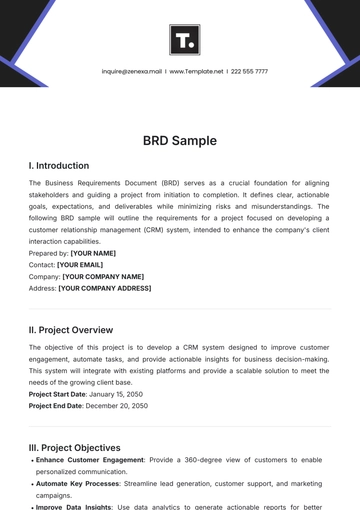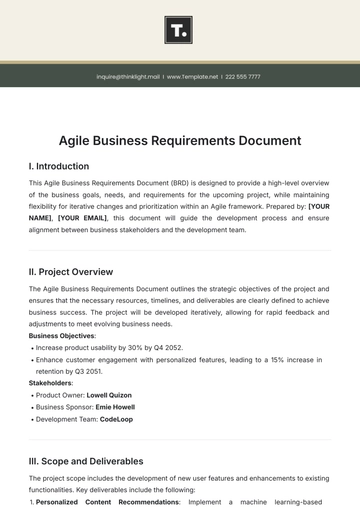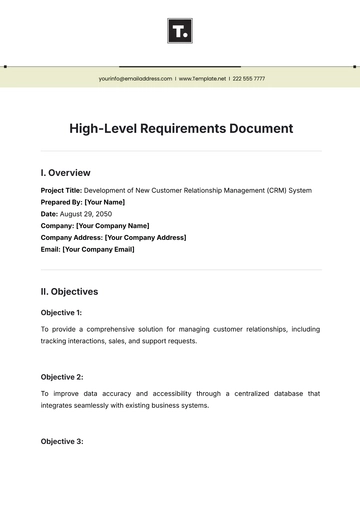Free Business Analyst Requirements Document

Prepared by: [YOUR NAME]
Email: [YOUR EMAIL]
Date Created: March 3, 2050
Introduction
This Business Analyst Requirements Document (BARD) outlines the business needs, goals, and high-level requirements for the “Next-Generation Digital Customer Platform” project. By detailing objectives and project scope, this document ensures alignment with core business priorities, paving the way for an efficient development process and successful project delivery.
I. Project Overview
The Next-Generation Digital Customer Platform is designed to streamline user interactions, enhance personalization, and improve customer satisfaction. Targeted for launch in Q4 of 2050, this platform aims to redefine customer engagement across all digital channels and expand market share.
II. Purpose and Objectives
Purpose: Define the key business requirements to guide the development of an integrated digital platform that enhances user experience and loyalty.
Objectives:
Enable real-time personalization for each customer interaction.
Increase customer engagement metrics by 30% within the first year post-launch.
Support seamless cross-platform interactions across mobile, web, and tablet devices.
III. Project Scope
The scope includes developing, testing, and deploying a unified digital platform with key features such as predictive analytics, automated customer support, and a user-friendly design. The scope excludes legacy system integration and hardware infrastructure upgrades.
Item | Description | In Scope | Out of Scope | Target Date |
|---|---|---|---|---|
Predictive Analytics | Personalized content recommendations | ✓ | May 15, 2050 | |
Automated Support | AI-driven customer support | ✓ | June 10, 2050 | |
Mobile Integration | Full integration for all mobile devices | ✓ | August 3, 2050 | |
Legacy System Integration | Linking with outdated systems | ✓ | N/A | |
Infrastructure Upgrade | Hardware upgrade for new system | ✓ | N/A |
IV. Requirements Gathering Process
Key stakeholders, including customer service leads, marketing, IT, and design teams, were engaged in structured workshops and surveys from March 20 to April 3, 2050. This collaborative approach ensured comprehensive requirements collection, enabling alignment with each department's specific needs.
V. Functional Requirements
Personalized User Experience
Requirement: The platform must track and analyze customer behaviors to personalize content and promotions.
Priority: High
Due Date: June 25, 2050
Real-time Customer Support
Requirement: Enable 24/7 AI-powered support with live agent escalation options.
Priority: High
Due Date: July 5, 2050
Cross-Platform Consistency
Requirement: Ensure identical user experience across all digital channels.
Priority: Medium
Due Date: August 12, 2050
VI. Non-Functional Requirements
Performance: Platform must handle up to 1 million concurrent users with <1 second response time.
Scalability: System must support future enhancements without significant reengineering.
Security: Must comply with industry standards (e.g., ISO 27001) to protect user data privacy.
VII. Stakeholder Alignment
Monthly review sessions are scheduled to ensure continuous alignment with stakeholders.
Next Review Date: May 5, 2050. Feedback mechanisms, including quarterly satisfaction surveys, will be implemented to track the platform’s impact on user engagement.
VIII. Conclusion
This document serves as a blueprint for the development and successful deployment of the Next-Generation Digital Customer Platform, aligned with the strategic business goals to enhance customer engagement and satisfaction. Following these defined requirements will ensure timely delivery, meeting both current and future business needs.
- 100% Customizable, free editor
- Access 1 Million+ Templates, photo’s & graphics
- Download or share as a template
- Click and replace photos, graphics, text, backgrounds
- Resize, crop, AI write & more
- Access advanced editor
The Business Analyst Requirements Document Template from Template.net is a fully customizable and editable solution designed for professionals. With its easy-to-use layout, you can quickly tailor it to suit your project's needs. Powered by the AI Editor Tool, this template simplifies the process of creating detailed, clear requirements documents for your business analysis tasks.





























